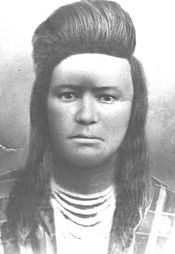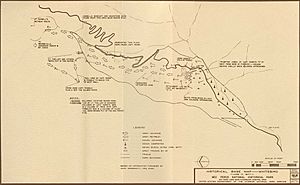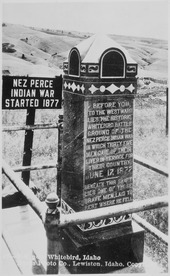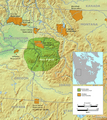Battle of White Bird Canyon facts for kids
Quick facts for kids Battle of White Bird Canyon |
|||||||
|---|---|---|---|---|---|---|---|
| Part of the Nez Perce War | |||||||
 White Bird Battleground panorama, Idaho, 2003 |
|||||||
|
|||||||
| Belligerents | |||||||
Volunteers |
Nez Perce Native American Tribe | ||||||
| Commanders and leaders | |||||||
| Capt. David Perry Capt. Joel Graham Trimble |
Chief Joseph Ollokot White Bird |
||||||
| Strength | |||||||
| 106 soldiers; 11 civilian volunteers, 13 Nez Perce scouts | about 70 warriors | ||||||
| Casualties and losses | |||||||
| 34 killed 4 wounded |
3 wounded | ||||||
The Battle of White Bird Canyon was the first major fight of the Nez Perce War. It happened on June 17, 1877, in what was then Idaho Territory. This battle was a big defeat for the U.S. Army. It took place in the western part of today's Idaho County, near the city of Grangeville.
Contents
Why the War Started
The Nez Perce people and the U.S. government signed a treaty in 1855. This treaty set aside land for the Nez Perce that included their traditional homelands. But in 1860, gold was found on the Nez Perce Indian Reservation. This discovery brought many miners and settlers into the area. Even though their treaty was often broken, the Nez Perce tried to keep the peace.
In 1863, the U.S. government wanted more land for settlers. They forced a new treaty on the Nez Perce, which made their reservation 90% smaller. Leaders of the Nez Perce bands who lived outside this new, smaller reservation refused to sign it. They continued to live on their ancestral lands until the spring of 1877.
In May 1877, after some conflicts with the U.S. Army, the Nez Perce bands who hadn't signed the new treaty began to move. They were heading towards the smaller reservation. Chief Joseph's band, the Wal-lam-wat-kain, lost many horses and cattle while crossing swollen rivers. Joseph's and Chief White Bird's bands eventually met at Tepahlewam. This was a traditional camping spot on the Camas Prairie near Tolo Lake. They wanted to enjoy their traditional way of life for a few more days. Not everyone agreed with trying to keep the peace.
On June 14, some young Nez Perce men, upset by past events and the loss of their lands, attacked settlers in the Salmon River area. These attacks continued on June 15, leading to the deaths of several settlers. People from the community of Mount Idaho quickly sent messages to Fort Lapwai. They asked the military for help.
The Nez Perce at Tepahlewam knew that General O. O. Howard was preparing to send soldiers. By June 16, the bands had moved to the southern end of White Bird Canyon. This canyon was about five miles long and one mile wide. That night, lookouts reported that U.S. soldiers were coming from the north. After much discussion, the Nez Perce decided to stay at White Bird. They hoped to avoid war, but they were ready to fight if they had to.
Who Fought in the Battle
Captain David Perry and Captain Joel Graham Trimble led two companies of the U.S. 1st Cavalry Regiment. They had 106 soldiers in total. Eleven civilian volunteers and 13 Nez Perce scouts also rode with them. Many of the soldiers were new to fighting and not very good at riding or shooting. Their horses were also not trained for battle. Both the men and horses were very tired after riding over 70 miles for two days to reach White Bird Canyon.
The Nez Perce had about 135 warriors. However, they had taken a lot of whiskey during their raids. On the morning of June 17, many men were not able to fight. Only about 70 warriors took part in the battle. Ollokot and White Bird led roughly equal numbers of fighters. Chief Joseph may have been there, but he was not a war leader. The Nez Perce had only about 45-50 firearms. These included shotguns, pistols, and old muskets. Some warriors fought with bows and arrows.
Even though the Nez Perce had not fought against White soldiers before, they knew the land very well. They were also excellent horsemen, and their Appaloosa horses were well-trained. The Nez Perce were also very good shots. They usually got off their horses to fire, and their horses would stay calm. In contrast, many U.S. Cavalry horses panicked during the battle. This panic was a big reason for the U.S. defeat.
Attempting a Truce
At dawn on June 17, the Nez Perce were ready for the soldiers. Fifty warriors led by Ollokot waited on a hill on the west side of the canyon. Fifteen warriors led by Two Moons were on a hill to the east. This placed them on both sides of the cavalry's path. Six Nez Perce warriors waited with a white flag. They hoped to talk and make peace with the soldiers.
The soldiers, volunteers, and scouts rode down into White Bird Canyon. A small group of soldiers and a civilian volunteer named Arthur "Ad" Chapman met the Nez Perce truce party first. Yellow Wolf, a Nez Perce warrior, later said:
- Five warriors, led by Wettiwetti Houlis...had been sent out from the other [west] side of the valley as a peace party to meet the soldiers. These warriors had instructions from the chiefs not to fire unless fired upon. Of course they carried a white flag. Peace might be made without fighting.
For reasons that are still unclear, Chapman fired at the truce party. The Nez Perce fighters quickly took cover and fired back.
The Battle Begins
After the first shots, Lieutenant Theller and his men got off their horses. They spread out on a low ridge. Trumpeter John Jones was told to signal for all troops to come forward. But before Jones could finish his trumpet call, he was shot off his horse by a Nez Perce warrior named Otstotpoo. Otstotpoo was over 300 yards away. Captain Perry's company got off their horses and formed a line on the east side. Captain Trimble's company stayed on their horses and formed a line on the west side. The civilian volunteers tried to get into position on a ridge to the east.
Captain Perry thought his left side was safe because of the volunteers. But he couldn't see them. The volunteers, now led by George Shearer, soon met Nez Perce warriors hiding in the bushes. Shearer told his men to get off their horses and fight. A few obeyed, but most of them left the battle and ran away. Shearer and his few remaining men went to the top of the ridge. There, Shearer found himself caught between the Nez Perce attack on Perry's left side and fire from warriors protecting the Nez Perce camp.
Perry tried to move forward and attack the Nez Perce. He ordered his men to drop their rifles and get out their pistols. He wanted Trumpeter Daly to sound the charge, but Daly had lost his trumpet. Without the trumpet, Perry couldn't tell his troops what to do, and the charge never happened. Perry then decided to make a stand on the ridge. He ordered every fourth man to take the horses to a safe spot. Perry and the rest of his soldiers then moved forward on foot to the ridge.
Meanwhile, Captain Trimble's company tried to spread out on the ridge while still on their horses. This was a disaster. The horses were scared, and the soldiers were not good at shooting from their terrified horses.
Captain Perry, riding between the two companies, saw the volunteers running away. Several things then happened that sealed the U.S. defeat. Perry's left side and Trimble's right side were now open to attack. Captain Trimble sent Sergeant Michael M. McCarthy and six men to the highest point above the battle to protect his right side. Perry also noticed this high point and tried to send soldiers to help McCarthy.
The Retreat
Seeing his army's side collapsing, Perry tried to get his men to move to McCarthy's position. He wanted them to make a stand on the high ground about 300 yards to the south. But Company F, confused and having many injured soldiers, thought Perry's order meant a full retreat. Company H, seeing Company F running away, also joined the flight. This left McCarthy and his men stranded.
Sensing victory, Ollokot's mounted warriors chased the retreating soldiers. McCarthy, realizing he was cut off, galloped towards the fleeing troops. Captain Trimble ordered McCarthy and his six men to return to his position to try and take the high ground. But Trimble couldn't get any other troops to support McCarthy. McCarthy and his men held off the Nez Perce for a short time and then retreated. They couldn't catch up with Trimble's main group. McCarthy's horse was killed, but he survived by hiding in the bushes for two days. He then walked to Grangeville. He later received a Congressional Medal of Honor for his bravery in the battle.
The soldiers retreated in two main directions. Lieutenant Parnell and Lieutenant Theller led groups trying to go back the way they came. Under fire, Theller got trapped in a steep, rocky ditch. He ran out of ammunition, and he and his seven men were killed by the Nez Perce. Captain Perry and Captain Trimble fled to the northwest, up steep ridges. They reached the Camas Prairie on top of the ridge. There, they were able to gather their remaining men at Johnson's Ranch. Within minutes, Nez Perce warriors attacked again. The survivors continued their retreat for several miles towards Mount Idaho, where fresh volunteers rescued them.
After the Battle
By mid-morning, 34 U.S. Cavalry soldiers had been killed, and two were wounded. Two civilian volunteers were also wounded. In contrast, only three Nez Perce warriors were wounded. The Nez Perce warriors collected about 63 carbines, many pistols, and hundreds of rounds of ammunition from the battlefield. These weapons greatly improved the Nez Perce's fighting power for the rest of the war. Two unknown soldiers from Company F are buried in Custer National Cemetery at Little Bighorn Battlefield. Lieutenant Theller's body was found and buried ten days after the battle. The bodies of many U.S. soldiers were missing for several days. They had fallen over a 10-mile stretch of land.
The Battle of White Bird Canyon was a huge victory for the Nez Perce. They were outnumbered two to one and fighting uphill with fewer and older weapons. But the Nez Perce used their fighting skills and knowledge of the land to win the first battle of the Nez Perce War.
After the battle, the Nez Perce crossed to the east bank of the nearby Salmon River. When General Howard arrived several days later with over 400 men, the Nez Perce taunted him from their side of the river. The Nez Perce, who were about 600 people (men, women, and children), were very good at crossing rivers. They moved with their elderly, women, children, tipis, belongings, and 2,000 horses and other animals. Howard had a hard time crossing the Salmon River with his men. But instead of fighting Howard's larger force, the Nez Perce quickly crossed back over the river. This left Howard stuck on the other side and gave the Nez Perce a head start in their escape from the U.S. Army.
White Bird Battlefield Site
|
White Bird Battlefield
|
|
| Lua error in Module:Location_map at line 420: attempt to index field 'wikibase' (a nil value). | |
| Nearest city | White Bird, Idaho |
|---|---|
| Area | 1,900 acres (7.7 km2) |
| NRHP reference No. | 74000332 |
| Added to NRHP | July 18, 1974 |
The White Bird Battlefield is a 1,900-acre area. It was added to the National Register of Historic Places in 1974.
Some or all of this area is part of the Nez Perce National Historical Park.
- Greene, Jerome A. (2000). A Nez Perce Summer 1877. Helena: Montana Historical Society Press. Accessed 27 Jan 2012
- Hampton, Bruce (1994). Children of Grace: The Nez Perce War of 1877. New York: Henry Holt and Company.
Images for kids







